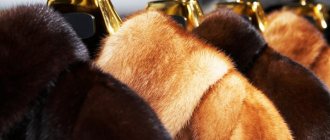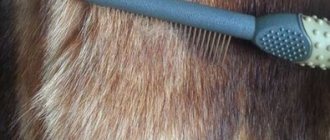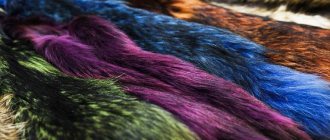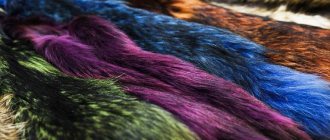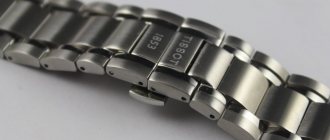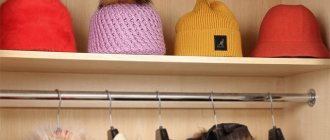Many women have been dreaming of their own mink coat for years, but only those who were able to buy the coveted new thing know that caring for it is sometimes not easy. It is especially annoying when, with intensive wear in certain places, the fur loses its attractiveness and becomes shabby. And too careful storage leads to an equally sad result - a mink coat becomes unfashionable, which is unbearable for any woman.
White fur coat
Shortening a fur coat. Brief instructions for use
Lay the fur coat on the table, fur side down, carefully straighten it from the collar, straighten the lining with your hand. Support the lining from below. There you will probably find insulation. It will have to be cut off along the bottom side - you can’t bend it like that, otherwise it will turn out rough.
Carefully cut off 3-4 cm of insulation (the data is based on the calculation that the main length of the product will be reduced by 5 cm). It turned out that the length of the lining is equal to the length of the fur coat, however, so that it does not peek out, it also needs to be shortened. Use temporary stitches to baste the bottom of the lining.
How to mark a cutting line for a fur coat
Next, outline the length of the fur coat. Mark the length that we will shorten with chalk directly on the skin. Check how clearly the insulation is cut. It is better to cut the skin not along the intended strip, but by retreating 3-4 cm more than the required length. We cut the skin with a special knife in a canopy, in no case with scissors.
We will cut a 3-4cm strip of lining fabric that matches the color of the original lining of the product. We place the fabric face to face on the fur, and baste with large stitches along the entire length. This part will be folded under, so there is no need to pull the fur out of the seam.
When basting, do not stretch the skin, otherwise the finished hem of the fur coat will form an unsightly wave. You can sew the seam by machine. We sew on the fabric, because the machine will slide on the leather, stretching it. Sew at a distance of 0.5 cm from the edge. Now you can remove the basting.
Making changes to the style of a fur coat
You can improve the style a little, which will change the mink coat and become fashionable again, with your own hands. There is no need to go to a studio and pay a fairly large amount for simple work.
There are several methods to give a modern look to a fur coat, which can be done at home:
- trim the hem;
- shorten the sleeves;
- change collar;
- make trims from other fur at the cuffs, collar and hem.
Processing the bottom edge of the fur coat. What is important
Let's return to the strip drawn along the flesh; we will bend the skin along it. Let's start from the side. Carefully fold the fabric on the edge to create a smooth edge. If there is something in the way inside, or the layer seems too thick, don’t be afraid to cut off the excess.
We bend the main board and baste the edge of the board. Focusing on the line we made, we bend the edge and baste along the entire length to the other edge. It is better to make a basting with a colored thread, so it is easier to remove it later. Time for the next fitting - we check that the bottom of the fur coat is even, including along the sides.
Marking and shortening
It’s great if a relative or friend helps at the first stage. Namely, you need to determine the length to which you need to cut, and then smoothly mark it in a circle. If you have to work with your own hands, you can make a mark on both sides of the sides. In both cases, the length is double-checked:
- the product is spread out;
- carefully steam the lining with a blade or nail scissors;
- take measurements from the mark made at which the fur coat needs to be cut, and to the bottom;
- carry out preliminary markings throughout the entire product, constantly checking to see if there are any distortions;
- cut off the excess part with a tolerance of 3-4 cm per hem.
The excess part of the fur is cut off exclusively at the core, without in any way damaging the fur. The first stage of work ends here, but it’s not a bad idea to try on the already shortened fur coat again and check its length before the final work, as in the video.
Completion of reconstruction
It is much easier to trim the lining that hangs down during fitting, using existing data. The process of cutting the lining is the same as in the case of the base. Measurements are taken along the entire width, markings are applied with an allowance for the subsequent hem, and excess material is cut off. Insulation in the form of padding polyester or batting, if any, should also be removed.
Using a suitable medium-weight fabric, cut out a strip of braid, the edges of which are processed by machine or by hand. Next, it is applied to the face of the product with the front side and is fixed with contrasting threads with a large stitch so as not to pull the base. After trying on, if everything is done correctly and the bottom does not stretch, you can sew the braid thoroughly with threads that already match the tone of the fur coat.
You can sew either by machine or by hand. After all, in fact, a lot of fur coats, even from famous designers, are created by hand. At least, most of the operations involved in sewing them, although far from being done at home.
The final stage of work is fixing the top strip of braid, and then folding the lining. Difficulties can arise only if the fur coat has a flared bottom. Excess lining material will gather in folds, get in the way, and spoil the figure. The excess fabric needs to be trimmed, stitched along the sides and back, and only then can you start tucking. At the end, the fur coat needs to be combed well, freeing any lint that may have been pulled in during sewing, and leaving the new thing hanging on a hanger. That's all: the situation has been corrected, the owner of a fashionable fur coat can again go out in a new thing, catching admiring glances.
What length of insulation on a fur coat is needed?
Check again to see if the length of the insulation is in the way. We remove the excess, level the fur coat on the table, and baste the strip sewn to the fur onto the insulation. We seal both sides. Let's straighten the fur coat on the table and check the length of the lining. If the fur coat is flared, the lining will need to be sewn in according to the width of the product.
We do this by basting from the inside of the lining, in two seams on the sides, then stitch it by machine. Let's check the lining: there should be no large folds or tension.
Take a thread that matches the color of the fur coat, and hand sew the bottom basted strip of fabric to the fur coat, piercing and catching the fur. Then remove the basting from the bottom of the hem. The lower corners of the bead must be sewn on by machine, and then be sure to comb with a special brush to straighten the fibers caught in the stitching.
How to shorten a fur coat made of natural fur
You should not undertake a complete recut of a natural fur coat at home. Only a specialist - a furrier - can handle this work. Therefore, it is better to contact a fur studio.
But, if the bottom of the sleeves or the bottom of the fur coat is worn out or damaged by the salt that is abundantly sprinkled on our streets, then the fur coat can be helped by shortening the bottom. It's not as difficult as it seems. All you need is desire and patience, because almost all the work is done manually.
For work we need
- blade or sharp knife;
- short and sharp needles for handwork;
- strong threads to match the color of the fur coat lining;
- a thimble and cotton braid 1-2 cm wide, equal in length to the bottom of the fur coat.
Step 1
So, first you need to carefully examine the bottom and mark all the damaged areas, then try on the fur coat and determine its new length.
You can either shorten it a little or solve the issue radically - make a short fur coat out of a long fur coat. The operating principle is the same.
Then you need to tear off the lining at the hem just above the marked new hem line. As a rule, the lining of fur coats is made to be loose (not sewn on the bottom).
Step 2
Lay the fur coat out on a flat surface, fold the lining up and use a pen to draw a new hem line right along the flesh. It is better to do this by measuring the required distance from the old bottom line.
Use a blade or a sharp paper knife to carefully cut the flesh, being careful not to damage the fur.
Immediately after cutting, vacuum the edges of the cut to remove all excess hair.
Step 3
Put the fur coat on yourself or a mannequin and mark the hem line on the lining exactly along the bottom of the fur coat.
Step 4
Trim the bottom of the lining 4 cm below the cut edge of the fur coat.
Lay the fur coat out on the table and level (cut more precisely) the bottom of the lining. The cut piece of lining (if it is more than 20 cm) will be useful to us, do not throw it away.
Step 5
The mesh is quite elastic, so it can stretch under the foot of a machine or overlocker. Using a not very hot iron, carefully glue a strip of non-woven fabric to the bottom of the fur coat using a not very hot iron.
Important! The core shrinks under steam, so we glue the strip without steam, using a dry iron. First try this on a cut piece of fur.
If the core is changed under the iron, then it is better to baste the non-woven strip by hand.
Step 6
Apply the cotton braid from the fur side and sew it with a narrow overlock using an overlocker (you can do it manually over the edge or using a machine). Place the stitch from the side of the braid.
Step 7
Fold the bottom of the fur coat with the braid inside out and pin it. In the corners of the hems, fold the corner so that the hem of the bottom does not peek out from the front side, i.e., like an envelope. The width of the hem can vary from 1 to 4 cm depending on the style.
Step 8
We hem the bottom, basting the braid. This is not easy to do, the flesh is difficult to pierce, so we take a short needle (it will not bend) and a thimble. We make the stitch so that it is shorter along the core. This way the stitches will not be visible from the front side. Then we manually sew up the corner at the hem. Comb the fur along the bottom, removing traces of stitches.
Step 9
We iron the cut piece of lining; if it does not fit, take a new lining in the same color and cut out a strip 20 cm wide to match the shape of the bottom.
Long sections of the lining must be ironed inside out.
Step 10
Place the lining on the bottom of the fur coat and pin it on top of the braid. At the edges, we tuck short sections of the lining strip under the edges.
Step 11
Sew the lining to the braid along the bottom using a blind stitch. The core is not caught, so sewing is not difficult.
Sew the top edge of the lining strip to the inside of the fur coat. This work is more difficult, so we use a thimble. We take threads that match the lining, so the stitches will not be so noticeable.
What is this lining for? Firstly, the inner layer is light; when the lining is removed, it will not be visible at the bottom. Secondly, the lining strip will protect the inner layer from wear and contamination.
Sewing from genuine leather: master class
Step 12
Fold the bottom of the lining twice so that it is shorter than the bottom of the fur coat by the width of the hem of the fur and iron it.
Stitch the hem of the lining. The width of the hem is 3-4 cm. You can lay any decorative stitch along the bottom of the lining.
Step 13
Sew the torn lining to the lining. It also has cotton tape, so the lining is sewn on top of the tape.
This is what should happen. Only the lining is visible at the bottom. Mezdra is protected.
Step 14
Grab the lining on the sides of the fur coat using long stitches with wrapping - brids.
Ready! The fur coat will still serve and keep you warm in the cold.
You can also shorten the sleeves in the same way.
Svetlana Khatskevich
Svetlana graduated from a university with a degree in Sewing Technological Engineer.
She has been teaching sewing technology for over 20 years. He is a senior teacher at Burda Academy. We know Svetlana from her work on the site since its inception. She generously shares her knowledge and infects with her love of sewing. Sewing is creative, fun and educational. Welcome to this bright and interesting world! Author of the master class and photo: Svetlana Khatskevich Material prepared by Yulia Dekanova
Processing the side of a fur coat with decorative braid
All that remains is to seal the lower part of the side with decorative braid. Take a matching thread and hand sew the border with invisible stitches along the very edge. Then carefully hand sew the braid on. Remove all bastings. The lining should float a little.
Working with mink fur is always very responsible and painstaking work. If you do not have the necessary furrier skills and are afraid of ruining the product, contact Mobile Tailor, we will be happy to help you.
<< Back to Lifehacks Studio
